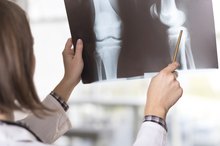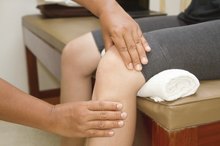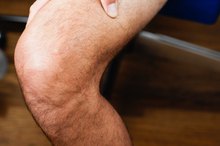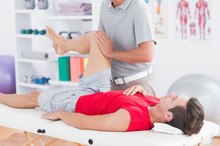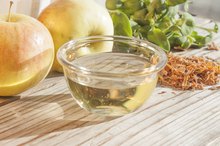What does fact checked mean?
At Healthfully, we strive to deliver objective content that is accurate and up-to-date. Our team periodically reviews articles in order to ensure content quality. The sources cited below consist of evidence from peer-reviewed journals, prominent medical organizations, academic associations, and government data.
The information contained on this site is for informational purposes only, and should not be used as a substitute for the advice of a professional health care provider. Please check with the appropriate physician regarding health questions and concerns. Although we strive to deliver accurate and up-to-date information, no guarantee to that effect is made.
How to Get Rid of Fluid on Knee
If you have excess fluid around your knee joint, you may experience stiffness, bruising and pain when you place weight on the knee 1. In addition, you’ve probably noticed that your affected knee appears larger or puffier than your other knee. The excess fluid on the knee can be the result of trauma such as a ligament tear or overuse injuries or the result of underlying conditions you have such as an infection or arthritis 1. You can get rid of excess fluid on the knee at home and with treatments from your doctor 1.
If you are experiencing serious medical symptoms, seek emergency treatment immediately.
How to Get Rid of Fluid on Knee
Rest your knee. Avoid activities that bear weight on you knee when you experience symptoms such as pain and inflammation. Instead elevate your knee higher than your heart. You can use pillows for comfort; then use cold therapy. Apply ice to your knee for 15 to 20 minutes approximately every two hours. Instead of a bag of ice, you can also use an iced towel from the freezer or a bag of frozen vegetables. The cold therapy will control the inflammation and swelling. To relieve the pain, take acetaminophen, such as Tylenol. Or use nonsteroidal anti-inflammatory drugs (NSAIDs), such as Motrin or Advil, to relieve pain and inflammation.
What Causes Fluid on Your Knee?
Learn More
Try exercise. You may want to manage your weight to relieve pressure on the knee 1. Weight loss can minimize the amount of body weight your knees have to support during activities such as walking or sports. If your quadriceps or hamstring muscles are weak, your doctor could recommend that you work with a physical therapist to strengthen your muscles, so they can better support your knees.
Treat the cause of your knee effusion or excess fluid. Your doctor can remove the excess fluid in the knee through an aspiration procedure. The procedure also will relieve the pressure on your joint caused by fluid buildup. After the aspiration procedure, your doctor may inject corticosteroid into your knee joint. This will treat the inflammation in your affected knee. If you suffer from gout, a condition where crystal deposits to form in your joints and cause inflammation, your doctor could prescribe medication. For instance, your doctor can recommend colchicine for acute gout attacks and NSAIDs or allopurinol after an attack ends.
How Long Does it Take to Rehab From Meniscus Surgery?
Learn More
Undergo surgery. If home remedies and treatments do not work, your doctor may look inside your knee joint. The arthroscopic knee surgery is used to examine your knee joint for wear and tear. Also, your doctor can repair damage to your knee. If you are diagnosed with osteoarthritis of the knee, you may need additional surgery. Typically your doctor will recommend knee-replacement surgery if you can no longer bear weight on your knee without extreme pain.
- Avoid activities that bear weight on you knee when you experience symptoms such as pain and inflammation.
- If your quadriceps or hamstring muscles are weak, your doctor could recommend that you work with a physical therapist to strengthen your muscles, so they can better support your knees.
- After the aspiration procedure, your doctor may inject corticosteroid into your knee joint.
Related Articles
References
- Mayo Clinic: Water on the Knee
- Lespasio MJ, Piuzzi NS, Husni ME, Muschler GF, Guarino A, Mont MA. Knee Osteoarthritis: A Primer. Perm J. 2017;21:16-183. doi:10.7812/TPP/16-183
- Kiapour AM, Murray MM. Basic science of anterior cruciate ligament injury and repair. Bone Joint Res. 2014;3(2):20-31. doi:10.1302/2046-3758.32.2000241
- Doral MN, Bilge O, Huri G, Turhan E, Verdonk R. Modern treatment of meniscal tears. EFORT Open Rev. 2018;3(5):260-268. doi:10.1302/2058-5241.3.170067
- Reinking MF. CURRENT CONCEPTS IN THE TREATMENT OF PATELLAR TENDINOPATHY. Int J Sports Phys Ther. 2016;11(6):854-866.
- Petersen W, Rembitzki I, Liebau C. Patellofemoral pain in athletes. Open Access J Sports Med. 2017;8:143-154. doi:10.2147/OAJSM.S133406
- Frush TJ, Noyes FR. Baker's Cyst: Diagnostic and Surgical Considerations. Sports Health. 2015;7(4):359-65. doi:10.1177/1941738113520130
- Huang YC, Yeh WL. Endoscopic treatment of prepatellar bursitis. Int Orthop. 2011;35(3):355-8. doi:10.1007/s00264-010-1033-5
- Beals C, Flanigan D. A Review of Treatments for Iliotibial Band Syndrome in the Athletic Population. J Sports Med (Hindawi Publ Corp). 2013;2013:367169. doi:10.1155/2013/367169
- Tsai CH, Hsu CJ, Hung CH, Hsu HC. Primary traumatic patellar dislocation. J Orthop Surg Res. 2012;7:21. doi:10.1186/1749-799X-7-21
- Ragab G, Elshahaly M, Bardin T. Gout: An old disease in new perspective - A review. J Adv Res. 2017;8(5):495-511. doi:10.1016/j.jare.2017.04.008
- Lee PYF, Nixion A, Chandratreya A, Murray JM. Synovial Plica Syndrome of the Knee: A Commonly Overlooked Cause of Anterior Knee Pain. Surg J (N Y). 2017;3(1):e9-e16. doi:10.1055/s-0037-1598047
- Vaishya R, Azizi AT, Agarwal AK, Vijay V. Apophysitis of the Tibial Tuberosity (Osgood-Schlatter Disease): A Review. Cureus. 2016;8(9):e780. doi:10.7759/cureus.780
- Zanon G, Di vico G, Marullo M. Osteochondritis dissecans of the knee. Joints. 2014;2(1):29-36.
- Hindle P, Davidson E, Biant LC. Septic arthritis of the knee: the use and effect of antibiotics prior to diagnostic aspiration. Ann R Coll Surg Engl. 2012;94(5):351-5. doi:10.1308/003588412X13171221591015
- Gwinner C, Märdian S, Schwabe P, Schaser KD, Krapohl BD, Jung TM. Current concepts review: Fractures of the patella. GMS Interdiscip Plast Reconstr Surg DGPW. 2016;5:Doc01. doi:10.3205/iprs000080
- Voskuil R, Evenski AJ, Montgomery C, Emory CL. Malignant Bone Tumors of the Knee: How to Identify and Treat. J Knee Surg. 2019;32(4):305-314. doi:10.1055/s-0038-1675828
- Gupte C, St mart JP. The acute swollen knee: diagnosis and management. J R Soc Med. 2013;106(7):259-68. doi:10.1177/0141076813482831
- American Academy of Orthopedic Surgeons. Unstable Kneecap.
- Bhatia D, Bejarano T, Novo M. Current interventions in the management of knee osteoarthritis. Journal of Pharmacy & Bioallied Sciences 2013 Jan-Mar;5(1):30-38. doi:%2010.4103/0975-7406.106561
- Bronstein RD, Schaffer JC. Physical Examination of the Knee: Meniscus, Cartilage, and Patellofemoral Conditions. J Am Acad Orthop Surg. 2017 May;25(5):365-374.
- Browne K, Kurtz CA. How to perform a comprehensive examination of the knee. JAAPA. 2009 Jun;22(6):20-25.
- Hergenroeder AC, Harvey BS. (2017). Osteochondritis dissecans (OCD): Clinical manifestations and diagnosis. Bachur RG, ed. UpToDate. Waltham, MA: UpToDate Inc.
Writer Bio
This article was written by the CareerTrend team, copy edited and fact checked through a multi-point auditing system, in efforts to ensure our readers only receive the best information. To submit your questions or ideas, or to simply learn more about CareerTrend, contact us [here](http://careertrend.com/about-us).
